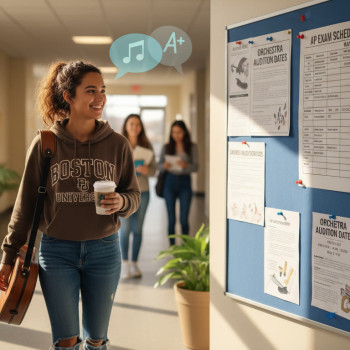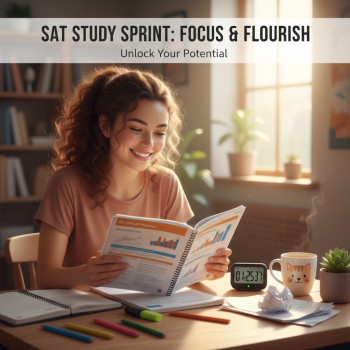When the Numbers Don’t Tell the Whole Story
Let’s be honest: college admissions can feel like a scoreboard sometimes. That 400–1600 number from the Digital SAT is easy to glance at, and easy to worry over. But admissions officers read stories, not just digits. A strong, authentic essay can change the frame of your application—especially when your SAT score is average. This article is a practical, warm guide for students (and the parents who cheer them on) who want to turn a vivid essay into the kind of evidence colleges remember.

Why a Great Essay Still Matters in the Age of the Digital SAT
Since the Digital SAT transitioned the testing experience, the score remains a useful, standardized snapshot of some academic skills. But colleges look for context. The essay—your personal statement and supplemental answers—shows who you are when you aren’t bubbling answers on a screen. It reveals values, voice, resilience, curiosity, and intellectual spark. Those are the things schools are admitting for, not just test-taking ability.
Think of your application as a short documentary: test scores are the factual charts; your essay is the scene that makes viewers care. Even with a median or slightly below–median score, a compelling narrative can tilt an admissions officer’s impression because it provides reasons to believe in your potential beyond one test day.
Three truths to remember
- Your Digital SAT score doesn’t erase what your writing proves about your thinking.
- Admissions officers evaluate fit—how well you’ll contribute to their community—not just raw numbers.
- Strategy matters: when your essay is strong, make sure the rest of your application supports and amplifies that story.
Start with Self: Picking the Right Story
Your essay should do two things at once: reveal something about you, and demonstrate qualities colleges care about (curiosity, resilience, leadership, empathy, creativity). When the SAT score is average, you want the narrative to confidently show growth, context, or exceptional alignment with your intended major or interests.
How to choose a winning topic
- Pick a moment that changed how you see the world—small moments can be as powerful as big ones.
- Choose specificity over grand statements. A concrete scene with sensory details reads as honest and memorable.
- Ask: does this essay add something new to my application? If your resume lists awards and activities, your essay should add depth, not repeat bullet points.
Structure That Sings: Crafting an Essay Admissions Remember
Structure is the invisible scaffolding of great essays. When your SAT is average, structure and clarity ensure your voice is heard clearly and the narrative makes an impression.
A simple structure that works
- Hook: A compelling opening that drops the reader into a moment (avoid clichés and summaries of the whole life).
- Context: Briefly explain the stakes—what was at risk? why did the moment matter?
- Conflict/Action: What did you do, feel, or decide? Show, don’t tell.
- Reflection: This is the heart. What did you learn? How did you change?
- Forward-looking conclusion: Tie it to the future—how will this shape your work in college? This matters especially when the SAT is average because it shows forward momentum.
Voice, not just correctness
Grammar and style are important, but admissions officers also want to hear who’s talking. Keep sentences varied, use concrete verbs, and avoid over-polished, robotic phrasing. Authenticity is persuasive—especially paired with clear, careful writing. If grammar errors are frequent, fix them; if your voice is muted, awaken it with small details.
Make the Essay Compensate Wisely—What to Emphasize
An average SAT score often raises questions in an admissions reader’s mind. You can preempt or answer those questions in a few smart ways:
Show academic seriousness beyond the test
- Mention independent projects, research, or challenging coursework that demonstrates intellectual engagement.
- Use your essay to show how you think—walk readers through your reasoning on a project, problem, or artistic process.
Explain context (sparingly and strategically)
If there are legitimate, brief reasons your test score doesn’t reflect ability (health, family duties, limited testing resources), it’s okay to provide concise context. This should never be a long apology—just one or two sentences that clarify, followed by a focus on growth.
Show resilience or compensating strengths
Maybe you’re the musician who practiced through a difficult year, or the first-generation student balancing jobs and schoolwork. Your essay can frame the score as one data point among many, while spotlighting persistence, leadership, or a distinctive talent.
Practical Page: How to Pair Essay Strategy with Application Tactics
Beyond the essay itself, there are practical steps to present a cohesive, confident application that diminishes the weight of an average SAT score.
1. Use your recommender letters to echo themes
Ask recommenders to highlight the behaviors and qualities your essay shows. If your essay focuses on curiosity and project-driven learning, a recommender can give concrete examples—this multiplies the story’s credibility.
2. Choose optional testing policies strategically
Many schools are test-optional or test-flexible. Research each college’s policy. If the school is strictly test-optional and your SAT is average, you can apply without sending scores. If you do send scores, make sure they are positioned with strong academic evidence elsewhere in the application.
3. Use supplemental essays to expand the story
Supplemental prompts are opportunities to reinforce themes. If your main essay shows personal resilience, a supplemental might showcase academic curiosity or community impact—build a multi-dimensional narrative across essays rather than repeating yourself.
4. Leverage subject tests and portfolios (where relevant)
For programs that value demonstrated skill—art, music, architecture—submit a portfolio or audition examples. These artifacts can speak louder than a standardized score in certain contexts.
Timeline and To-Do: A Realistic Roadmap (6–12 Weeks)
Concrete timelines help students and parents manage stress and make steady progress. Here’s a practical schedule if you’re polishing an essay while deciding how to handle an average Digital SAT.
| Weeks Before Deadline | Focus | Key Actions |
|---|---|---|
| 12–8 weeks | Drafting & Topic Choice | Choose topic; write 2–3 rough drafts; collect activity descriptions |
| 8–6 weeks | Feedback & Revision | Get teacher/mentor feedback; revise for structure and voice; address context if needed |
| 6–4 weeks | Polish & Proof | Copy-edit; check for clichés; ensure consistency with recommenders |
| 4–2 weeks | Final Review & Supplements | Finalize supplements; decide whether to send SAT scores; confirm recommenders will submit |
| 2–0 weeks | Submission & Follow-up | Submit apps early where possible; prepare for interviews or additional materials |
Examples: Essays That Complement an Average SAT
Here are three brief sketch examples to show how different narratives can strengthen applications when a test score is average.
Example 1 — The Researcher
Student A scored near the national median on the Digital SAT but spent two summers designing a low-cost water filtration prototype for a local community. Their essay walks the reader through the design failures, the late nights crunching filtration data, and the moment the prototype finally produced clear water. The takeaway isn’t that the student is a genius on standardized tests—it’s that they are curious, persistent, and able to apply scientific thinking to real problems.
Example 2 — The Caretaker
Student B juggled school with family caregiving responsibilities. The essay focuses on a single scene—a hospital waiting room conversation that taught the student to listen differently—and how that insight shaped their intention to study nursing. Short context explains the time constraints that affected test prep, but the narrative centers on empathy and purpose.
Example 3 — The Artist
Student C is a visual artist whose SAT sits in the average range. Their main essay narrates an artistic breakthrough—an installation piece that used reclaimed materials to explore memory. The supplemental portfolio shows technical skill; together, the application signals an artistic voice and seriousness of craft that admissions committees for arts programs will value.
Concrete Editing Checklist: Make Every Word Count
- Is the opening immediate and specific? Remove general statements.
- Does every paragraph move the narrative forward? Cut repetition.
- Does the reflection connect the past to future academic goals?
- Are there three or fewer sentences that mention the SAT or test-related context? Keep it brief.
- Have at least two people reviewed for clarity and tone—one content reader and one copy editor.
How Parents Can Help Without Writing the Essay
Parents play a huge role in emotional and logistical support. Here are ways to help that preserve student ownership:
- Provide structure: help create a revision schedule and quiet time for writing.
- Act as a sounding board: ask open questions about meaning and motivation instead of suggesting exact sentences.
- Proofread for grammar only if the student wants your help—don’t rewrite the voice.
- Help with logistics: collecting transcripts, ensuring recommenders submit on time, and checking application deadlines.
Where Tutoring and Personalized Guidance Fit In
Targeted coaching can make a measurable difference in both essays and test strategy. Personalized tutors help students identify the story that best represents them, tighten structure, and polish voice. Tutors who understand the Digital SAT can advise whether a student should retest, submit scores, or focus entirely on other parts of the application.
Programs offering 1-on-1 guidance, tailored study plans, and expert tutors—especially when supported by AI-driven insights—can give busy students an efficient path to stronger essays and smarter application choices. Sparkl’s personalized tutoring, for example, blends one-on-one mentorship with tailored study plans and AI-driven insights to help students amplify their strengths and present a cohesive story across essays, recommendations, and optional test decisions.
Deciding Whether to Send an Average Digital SAT Score
This is an important strategic choice. It depends on each college’s policy, the rest of your application, and how comfortable you are telling a story that reconciles your score with your abilities.
Quick decision guide
- If a school is test-optional and your application elsewhere is strong (GPA, coursework, essays, recommendations), seriously consider withholding a mediocre score.
- If you think the score will add context (e.g., it’s stronger than other indicators), submit it.
- If a school values demonstrated mastery in a particular area (e.g., STEM programs), prioritize subject-specific evidence like projects, portfolios, or advanced coursework.
Putting It All Together: A Sample Narrative Arc for an Application
Imagine an applicant whose Digital SAT is average but whose profile shows thoughtful engagement:
- Main essay: reveals a problem-solving temperament through a community project.
- Recommendations: a teacher and a supervisor who confirm initiative and teamwork.
- Coursework & Activities: AP and dual-enrollment classes demonstrating rigor or a portfolio showing skill.
- SAT decision: withheld at test-optional schools; sent to programs that request scores alongside other evidence.
That combined package tells a coherent, persuasive story. The test score is one datapoint; the narrative around it is what convinces admissions committees that you’ll thrive on campus.
Final Thoughts: Confidence, Clarity, and Consistency
College admissions is a human process inside an institutional frame. An average Digital SAT is not the end of the road; it’s a cue to be strategic. A stellar essay—honest, specific, and reflective—can reframe your application and spotlight qualities that tests don’t measure. Pair that essay with strategic decisions (recommenders who reinforce your themes, smart choices about score submission, and, if useful, targeted tutoring) and you’ll present an application that feels intentional and whole.
Remember: the admissions reader wants to meet the real you. If your writing opens a window to who you are and where you want to go, it can carry your application a long way.

Quick Resources Checklist
- Create a 12-week revision calendar for essays and supplements.
- Ask two recommenders who can provide distinct perspectives on your character and work.
- Decide on SAT submission plans college-by-college before finalizing applications.
- Consider targeted, personalized tutoring for focused essay workshops or test strategy—look for programs offering 1-on-1 guidance and tailored study plans.
One Last Encouragement
It’s natural to obsess over a number. But people—admissions readers, future teammates, professors—remember stories. Spend your time shaping yours: be specific, be honest, and show how your experiences have prepared you for the next chapter. With the right narrative, even an average Digital SAT score becomes just one small part of a larger, compelling portrait of who you are and what you’ll bring to college.
If you’d like, I can help you brainstorm essay topics, create a revision timeline, or draft a strategic plan for whether to send your Digital SAT scores to specific schools. We can also outline how a personalized tutoring program might fit into your timeline and goals—just say the word.














No Comments
Leave a comment Cancel